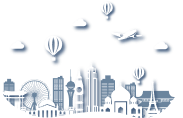
Planning a trip to Nepal
- Itinerary
- Hotels
- Flights
- Experiences
- Things to Carry
for the Trip
Things to do in Nepal in May
Visit Kathmandu Durbar Square, a UNESCO World Heritage Site known for its ancient palaces, temples, and shrines
Explore the bustling streets of Thamel and enjoy shopping for souvenirs
Relax at Garden of Dreams, a historical garden with a peaceful ambiance
Explore the International Mountain Museum to learn about the history and significance of the Himalayas
Take a short hike to World Peace Pagoda for panoramic views of Pokhara
Stroll around Lakeside and savor a delicious Nepali dinner at a local restaurant
Visit the Annapurna Butterfly Museum to witness a variety of butterfly species
Explore the Gurkha Memorial Museum to learn about the history of the Gurkha soldiers
Enjoy a serene evening at the Peace Stupa and witness a stunning sunset
The weather in Nepal in May is generally warm and humid. So we are suggesting you pack accordingly.
Things to Carry on your trip to Nepal
Clothing & Apparel
Lightweight, breathable clothing -
Nepal's climate is humid and warm, so pack light, loose clothing made from natural fibers like cotton or linen.
Hiking clothes -
If you plan on doing any trekking, pack comfortable, moisture-wicking hiking clothes.
Warm layers -
Evenings in Nepal can be cool, so pack a light jacket or sweater.
Rain gear -
Nepal's monsoon season runs from June to September, so pack a waterproof jacket and pants.
Comfortable shoes -
You'll be doing a lot of walking in Nepal, so pack comfortable shoes with good support.
Accessories
Wide-brimmed hat -
Protect your face from the sun and rain with a wide-brimmed hat.
Sunglasses -
Nepal's sun can be strong, so pack a pair of sunglasses to protect your eyes.
Scarf -
A scarf can be used for warmth, sun protection, or as a head covering.
Insect repellent -
Nepal is home to a variety of insects, so pack insect repellent to keep them away.
First-aid kit -
Pack a small first-aid kit with basic supplies like bandages, antiseptic, and pain relievers.
Essentials & Must Haves
Passport and visa -
Make sure your passport is valid for at least six months beyond your intended stay and that you have obtained the necessary visa.
Travel insurance -
Protect yourself against unexpected events with travel insurance.
Money -
Nepal's currency is the Nepalese rupee (NPR). You can exchange currency at banks, exchange bureaus, and hotels.
Credit cards -
Credit cards are widely accepted in Nepal, but it's a good idea to have some local currency on hand.
Phone and charger -
Make sure your phone is unlocked and that you have a local SIM card or international roaming plan.
Good to have
Water bottle -
Nepal's tap water is not safe to drink, so bring a reusable water bottle and fill it up with purified water.
Snacks -
Pack some snacks to keep you going between meals.
Travel towel -
A travel towel is lightweight and compact, making it easy to pack and use.
Headlamp -
A headlamp is useful for early morning or late-night activities.
Small backpack -
A small backpack is handy for carrying your essentials while exploring.
Electronics
Camera -
Capture your memories with a camera.
Power bank -
Keep your devices charged with a power bank.
Travel adapter -
Make sure you have the right travel adapter for Nepal.
Noise-canceling headphones -
Block out noise and enjoy your music or podcasts.
E-reader -
Bring an e-reader to keep up with your reading.
Payment Options -
Both cash and credit cards are widely accepted in Nepal. Some smaller businesses and street vendors may only accept cash.
Travel Apps in Nepal
Food Delivery Apps in Nepal
Hotels in Nepal
Local Experiences in Nepal

- Budget
- Tips to Save Money
Approximate Budget Range for your trip.
- Bargain at local markets for better prices on souvenirs
- Try local street food for an authentic culinary experience
*Disclaimer - Please note that the travel budget suggestions provided by Trip Garuda are generated through AI algorithms based on available data and user input. While we strive for accuracy, these estimates may not reflect real-time pricing or unforeseen expenses. We recommend using these figures as a general guide and encourage you to conduct further research and budgeting based on your specific travel requirements.





























